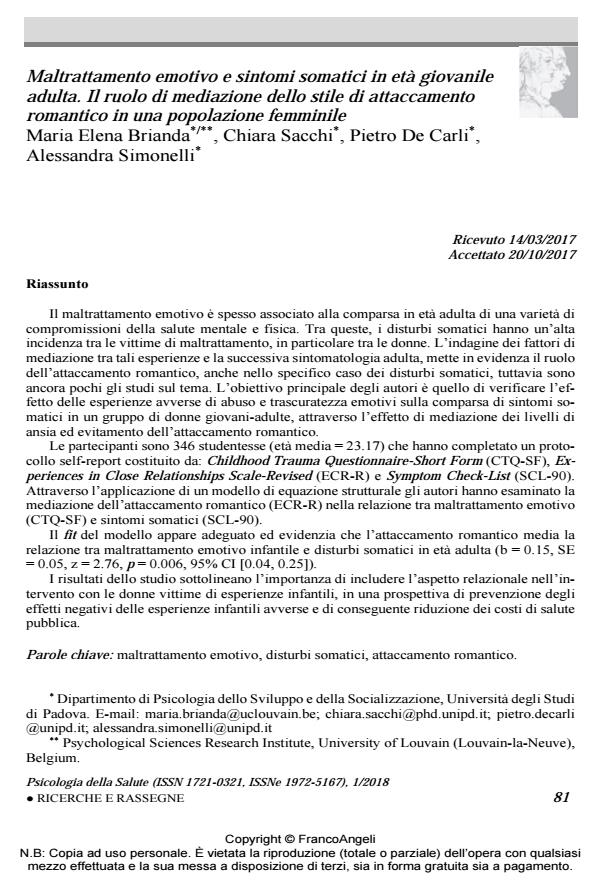Emotional maltreatment and early-adult somatization. The role of romantic attachment in a female group
Journal title PSICOLOGIA DELLA SALUTE
Author/s Maria Elena Brianda, Chiara Sacchi, Pietro De Carli, Alessandra Simonelli
Publishing Year 2018 Issue 2018/1
Language Italian Pages 21 P. 81-101 File size 330 KB
DOI 10.3280/PDS2018-001005
DOI is like a bar code for intellectual property: to have more infomation
click here
Below, you can see the article first page
If you want to buy this article in PDF format, you can do it, following the instructions to buy download credits

FrancoAngeli is member of Publishers International Linking Association, Inc (PILA), a not-for-profit association which run the CrossRef service enabling links to and from online scholarly content.
Emotional maltreatment is proved to be related to, or even predictive of, several psycho-logical and physical later impairments. Somatization has a higher incidence among individuals with a history of maltreatment, and among females. Studies highlighted the importance to investigate the role of mediating factors between childhood maltreatment and adult symp-tomatology. Although little is known about the specific case of somatic unexplained symp-toms, its relation with childhood maltreatment seems to be influenced by the role of romantic attachment. The main objective of our study is to check the effect of emotional maltreatment on early-adult somatization through the mediation of avoidance and anxiety levels of romantic attachment in a female group. Participants were 346 female students (mean age = 23.17) who completed a self-report protocol composed by the Childhood Trauma Questionnaire-Short Form (CTQ-SF), the Ex-periences in Close Relationships Scale-Revised (ECR-R) and the Symptom Check-List (SCL-90). A structural equation modelling has been applied in order to test the mediation of romantic attachment (ECR-R) in the relation between emotional maltreatment (CTQ-SF) and somatic symptoms (SCL-90). The total model fit resulted adequate and it proved that romantic attachment mediates the relation between emotional maltreatment and adult somatization (b = 0.15, SE = 0.05, z = 2.76, p = 0.006, 95% CI [0.04, 0.25]). Our results stress the importance to consider the relational level within intervention pro-grams for female victims of adverse childhood experiences. Addressing the treatment of these individuals towards the adult relational functioning might prevent negative effects of maltreatment and thus reduce public health costs.
Keywords: Emotional maltreatment, somatization, romantic attachment.
- How Does Trauma Make You Sick? The Role of Attachment in Explaining Somatic Symptoms of Survivors of Childhood Trauma Paul Samuel Greenman, Alessia Renzi, Silvia Monaco, Francesca Luciani, Michela Di Trani, in Healthcare /2024 pp.203
DOI: 10.3390/healthcare12020203
Maria Elena Brianda, Chiara Sacchi, Pietro De Carli, Alessandra Simonelli, Maltrattamento emotivo e sintomi somatici in età giovanile adulta. Il ruolo di mediazione dello stile di attaccamento romantico in una popolazione femminile in "PSICOLOGIA DELLA SALUTE" 1/2018, pp 81-101, DOI: 10.3280/PDS2018-001005